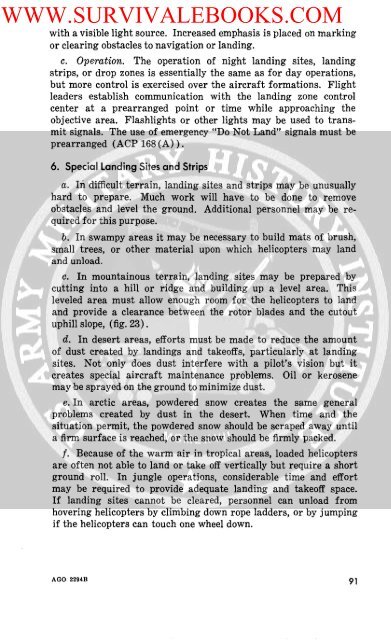FM 57-35 Airmobile Operations - Survival Books
FM 57-35 Airmobile Operations - Survival Books
FM 57-35 Airmobile Operations - Survival Books
- No tags were found...
Create successful ePaper yourself
Turn your PDF publications into a flip-book with our unique Google optimized e-Paper software.
WWW.SURVIVALEBOOKS.COMwith a visible light source. Increased emphasis is placed on markingor clearing obstacles to navigation or landing.c. Operation. The operation of night landing sites, landingstrips, or drop zones is essentially the same as for day operations,but more control is exercised over the aircraft formations. Flightleaders establish communication with the landing zone controlcenter at a prearranged point or time while approaching theobjective area. Flashlights or other lights may be used to transmit signals. The use of emergency "Do Not Land" signals must beprearranged (ACP 168 (A)).6. Special Landing Sites and Stripsa. In difficult terrain, landing sites and strips may be unusuallyhard to prepare. Much work will have to be done to removeobstacles and level the ground. Additional personnel may be required for this purpose.b. In swampy areas it may be necessary to build mats of brush,small trees, or other material upon which helicopters may landand unload.c. In mountainous terrain, landing sites may be prepared bycutting into a hill or ridge and building up a level area. Thisleveled area must allow enough room for the helicopters to landand provide a clearance between the rotor blades and the cutoutuphill slope, (fig. 23).d. In desert areas, efforts must be made to reduce the amountof dust created by landings and takeoffs, particularly at landingsites. Not only does dust interfere with a pilot's vision but itcreates special aircraft maintenance problems. Oil or kerosenemay be sprayed on the ground to minimize dust.e. In arctic areas, powdered snow creates the same generalproblems created by dust in the desert. When time and thesituation permit, the powdered snow should be scraped away untila firm surface is reached, or the snow should be firmly packed./. Because of the warm air in tropical areas, loaded helicoptersare often not able to land or take off vertically but require a shortground roll. In jungle operations, considerable time and effortmay be required to provide adequate landing and takeoff space.If landing sites cannot be cleared, personnel can unload fromhovering helicopters by climbing down rope ladders, or by jumpingif the helicopters can touch one wheel down.AGO 2294B 91
















